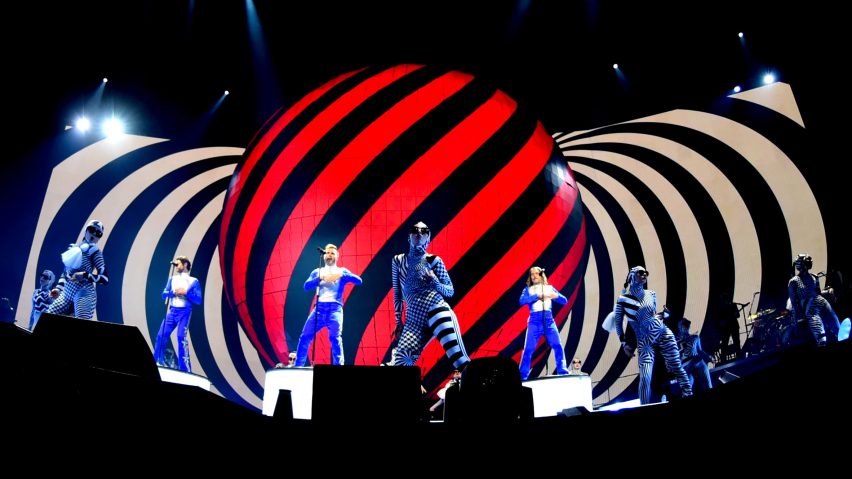A rotating 10-metre sphere is the centrepiece of the set for British pop group Take That's current world tour, which was designed by Stufish.
Stufish – that has previously worked with acts including The Rolling Stones, Madonna, U2 and Beyoncé – designed a 40-tonne 3D sphere with a cut-out section, covered in 2,800 digital panels.
It displays a host of video content throughout the show, mimicking spherical objects including a human eye, a globe and a mechanical security camera.
"The critical success of this show is the perfect storm of video content and set three-dimensionality," said Winkler, who is CEO and design director of Stufish, a London-based entertainment architecture studio founded by the late stage designer Mark Fisher.
"The audience is looking for something fresh that they can engage with," he told Dezeen. "Video is usually presented as a flat surface. Very rarely do we turn it into a 3D object."
Stage design based on Odyssey album cover
The architect worked closely with the band's creative director Kim Gavin and band member Mark Owen, who wanted the set design to reflect the album cover of their 2018 album Odyssey, which features a cream sphere with a segment cut out.
"Mark Owen wanted the stage to represent the Odyssey album logo, which we tried to emulate within the constraints of an actual set piece that needed to tour. We had the challenge of turning it into a tourable item," Winkler told Dezeen.
"It needed to satisfy all of the creative needs that the band and creative director Kim Gavin had in terms of choreographing the show, building the drama and the suspense," he explained.
Described by Winkler as "very clean and very simple", the stage features a large oval stage deck and two smaller oval stages on either side for the band's musicians, as well as the central sphere that "looks like a mirror ball".
It rotates 360 degrees using a slew ring, a giant electric motor-powered cog, and the same technology used to operate and turn tower cranes.
A 60-metre-long digital screen stretches across the back of the stage behind the sphere.
"The band wanted something different to what they'd done before," said Winkler.
Complete with trap doors, lifts and revolving staircases, the sphere's cut-out segment displays Take That's logo – a vertically mirrored double "T" emblem, as well as containing a stage area for parts of the show.
Set built from eight separate sections
With over 50 dates across Europe, the Greatest Hits tour, which kicked off last month, is designed for 15- to 20,000 capacity arenas.
Keeping the band involved at every level of the design process, Winkler and his team built 3D digital-models of the stage design on modelling software Rhino.
This was presented to the band using VR headsets, which – using VR software Vive – allowed them to navigate around the space, "from the middle of the front row to the seats at the very back of the arena".
The final stage components, including the sphere, were built over a period of four months, beginning in January this year.
A challenge faced by the team when designing the set was finding a way to disassemble and transport the sphere across cities without it being damaged.
"The design had to fit in with the touring schedule, fit into a certain amount of trucks and be demountable in a way that could be handled by the crew," said Winkler.
To remedy this, Winkler opted for a design made of eight separate sections that slot together "like a jigsaw puzzle".
"The sphere has a core inner structure made of steel, where the staircase is and the power runs through. Then there's a secondary frame that gives it its skin and a tertiary frame that is the digital media," he explained.
"It splits into eight large components that plug together. You attach these piece to a crane that lowers them one-by-one into the arena," he continued.
Winkler previously worked on Wonderland tour
Winkler joined Stufish after graduating from the Bartlett School of Architecture in 1996 and worked his way up, taking over the reins after the death of his mentor, Mark Fisher, in 2013.
In 2017, he designed the set for Take That's Wonderland tour, which featured a series of rectangular panels that moved across various formations.
"This tour is very 3D compared to the Wonderland tour in 2017," said Winkler.
He attributes this to recent advancements in digital media: "Content plays a massively important part in this because people want to see something they haven't seen before."
"Digital media is much lighter, brighter and easier to assemble now, while rendering times have shrunk to a fraction of what they used to be – processing power is better too, meaning that you can do real-time image processing," he explained.
"It's easier to tour, so a lot of set design is veered towards putting that into the set design formula. If you think you can get away with screensaver content, think again."

